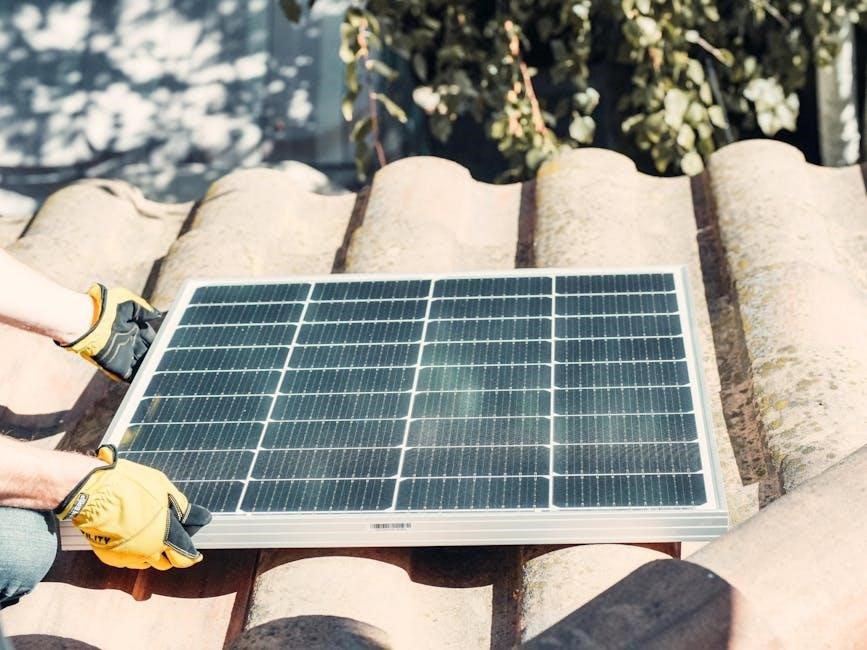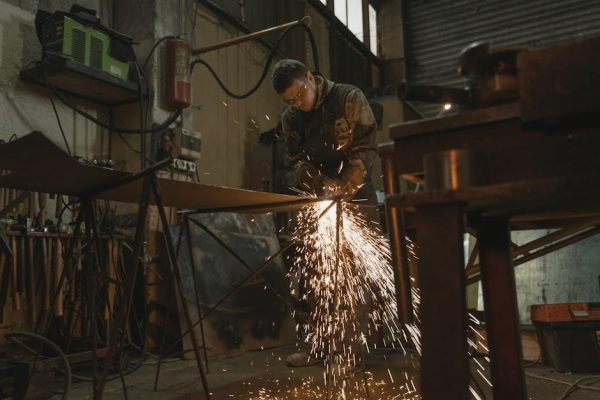This manual provides a comprehensive guide for installing the Honeywell TH6210U2001 T6 Pro Programmable Thermostat, covering key aspects such as system requirements, wiring, and step-by-step installation procedures for optimal performance.
1.1 Overview of the Honeywell TH6210U2001 Thermostat
The Honeywell TH6210U2001 is a programmable touchscreen thermostat designed for residential HVAC systems. It offers a user-friendly interface with a high-resolution color touchscreen display, making it easy to navigate and adjust settings. This thermostat is compatible with a wide range of heating, ventilation, and air conditioning systems, including single-stage, multi-stage, and heat pump configurations. It supports both conventional and heat pump systems, ensuring versatility for different home setups.
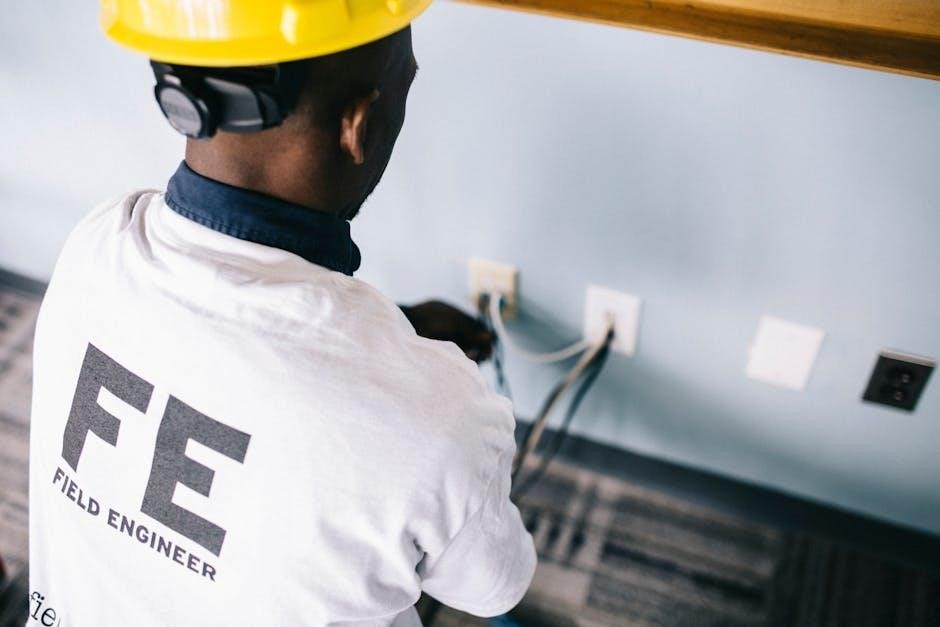
Key features include programmable scheduling, energy-saving modes, and smart home integration capabilities. The thermostat also provides remote access through Honeywell’s Total Connect Comfort app, allowing users to control temperatures from anywhere. Its sleek design and advanced functionality make it a popular choice for homeowners seeking efficiency and convenience.
The TH6210U2001 is designed to work with existing wiring in most homes, ensuring a seamless installation process. It is an excellent option for those looking to upgrade their thermostat to a modern, energy-efficient solution.
1.2 Importance of Proper Installation
Proper installation of the Honeywell TH6210U2001 thermostat is crucial to ensure optimal performance, safety, and energy efficiency. Incorrect installation can lead to malfunctioning, inaccurate temperature control, or even safety hazards. A well-installed thermostat guarantees that your HVAC system operates efficiently, reducing energy consumption and lowering utility bills.
Additionally, proper installation ensures that all safety features of the thermostat function correctly. For instance, features like automatic shutdown or temperature limits may not work as intended if the device is not installed according to the manufacturer’s guidelines. Improper wiring or setup can also void the product warranty, leading to potential financial losses.
Following the installation manual carefully and adhering to recommended practices helps avoid these issues. If unsure, consulting a licensed technician is advisable to ensure a safe and reliable setup. Proper installation is the foundation for enjoying the full benefits of this advanced thermostat.
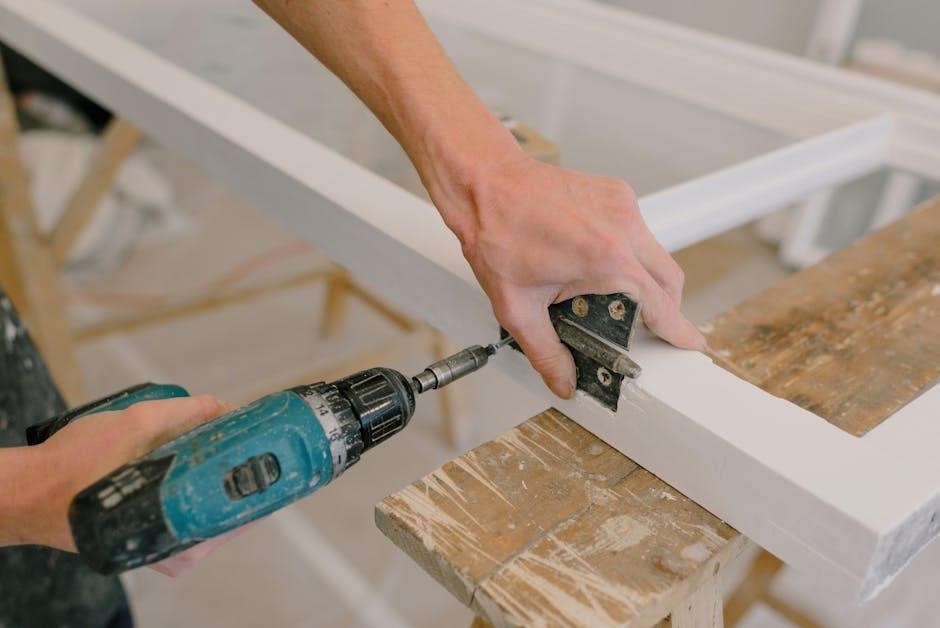
System Requirements and Compatibility
This section outlines the system requirements and compatibility for the Honeywell TH6210U2001 thermostat, ensuring it works with various HVAC systems and meets electrical specifications for safe operation.
2.1 Compatible HVAC Systems
The Honeywell TH6210U2001 thermostat is designed to work seamlessly with a wide range of HVAC systems, including forced air, heat pumps, and radiant floor heating systems. It is compatible with single-stage, two-stage, and multi-stage heating and cooling systems, making it versatile for various home configurations. Additionally, it supports both gas and electric furnaces, as well as air conditioning units. The thermostat is also compatible with systems that require auxiliary heat, such as heat pumps with supplemental heating. For multi-zone systems, the TH6210U2001 can be paired with appropriate zoning controls to ensure efficient temperature management across different areas of the home. Always verify compatibility with your specific HVAC system before installation to ensure optimal performance and proper operation. Proper system matching is essential for reliable heating and cooling control.
2.2 Electrical Requirements
The Honeywell TH6210U2001 thermostat requires a 24VAC power supply to function properly; It is essential to ensure that the HVAC system provides a common (C) wire for continuous power, especially if advanced features like Wi-Fi connectivity are to be utilized. The thermostat is compatible with systems operating at 24 volts AC, with a maximum current draw of 1VA. Proper wiring is critical to avoid damage or malfunction. The system should be connected to a circuit breaker or fuse box to ensure safe operation. Before installation, verify that the electrical system meets these specifications. If the existing wiring does not include a C-wire, additional wiring may be required. Always turn off the power to the HVAC system at the circuit breaker before performing any electrical work. Failure to meet these requirements may result in improper thermostat operation or damage to the device. Ensure compliance with local electrical codes and safety standards.
2.3 Necessary Tools for Installation
To ensure a smooth installation of the Honeywell TH6210U2001 thermostat, gather the following essential tools. A flathead screwdriver and a Phillips-head screwdriver are required for removing the old thermostat and mounting the new one. Wire strippers and pliers are necessary for preparing and connecting wires safely. A voltage tester is crucial to verify that the power is off before starting work. An adjustable wrench may be needed for tightening connections. A level ensures the thermostat is mounted straight for proper operation. Electrical tape and wire nuts are handy for securing wires and connections. A ladder or step stool may be needed if the thermostat is mounted high. Finally, keep the user manual readily available for reference. Having these tools on hand will help complete the installation efficiently and safely. Proper preparation prevents delays and ensures a successful setup.
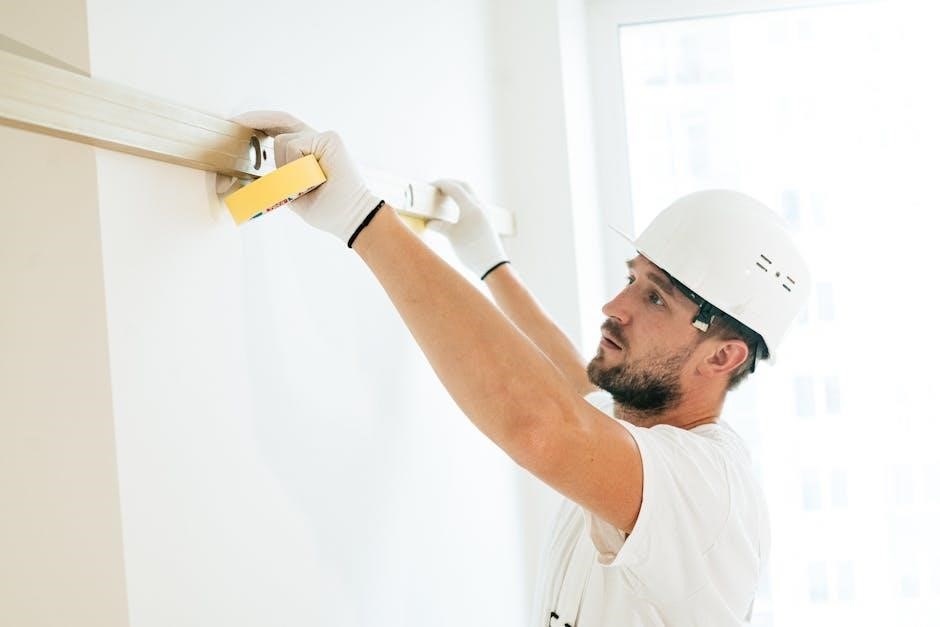
Step-by-Step Installation Guide
This guide provides a comprehensive walkthrough of installing the Honeywell TH6210U2001 thermostat. It covers preparation, removing the old thermostat, installing the new one, and completing initial setup.
3.1 Preparing the Installation Site
Before starting the installation, ensure the site is ready. Turn off the power to the HVAC system at the circuit breaker or fuse box. Verify the power is off using a voltage tester. Gather all necessary tools and materials, including a screwdriver, drill, and mounting hardware. Clean the area around the old thermostat to prevent dust or debris from interfering with the new installation. If upgrading from an old thermostat, carefully remove any existing mounting hardware. Label the wires if they are not already marked to ensure proper connection later. Ensure the wall where the new thermostat will be mounted is level and free of obstructions. If necessary, mark the wall for drilling pilot holes to secure the mounting plate. Proper preparation ensures a smooth and safe installation process. Always follow safety guidelines when working with electrical systems.
3.2 Removing the Old Thermostat
To remove the old thermostat, start by switching off the power to the HVAC system at the circuit breaker or fuse box. Verify the system is completely off using a voltage tester. Gently pull the thermostat away from the wall to access the wires behind it. Remove the screws holding the thermostat to the wall mount, taking care not to damage the wires or the wall. Once the thermostat is detached, carefully disconnect the wires from their terminals. If the wires are not labeled, mark them according to their positions to ensure correct reconnection later. Remove any additional components, such as a backplate or cover, and set them aside. Properly dispose of the old thermostat, especially if it contains mercury, by following local regulations. This step ensures a clean and safe transition to the new Honeywell TH6210U2001 thermostat. Always proceed with caution when handling electrical components.
3.3 Installing the New Thermostat Base
After removing the old thermostat, install the new Honeywell TH6210U2001 base. Begin by ensuring the wall surface is clean and level. Peel the backing from the adhesive strip on the back of the base and press it firmly onto the wall, aligning it with the previous mounting location or a new spot if preferred. If using screws, drill pilot holes, insert wall anchors, and screw the base securely into place. Use a level tool to ensure the base is perfectly horizontal. Once mounted, connect the wires to the corresponding terminals according to the wiring diagram provided in the manual. Avoid over-tightening the wire connectors to prevent damage. Double-check that all wires are properly seated and the base is securely fastened to the wall. This ensures a stable foundation for the new thermostat, allowing for accurate temperature control and smooth operation.
3.4 Mounting the Thermostat
Once the base is installed, mount the Honeywell TH6210U2001 thermostat onto it. Align the thermostat with the base, ensuring it is straight and properly seated. Gently push the thermostat onto the base until it clicks securely into place. If your model requires screws, insert them through the mounting holes and tighten gently to avoid damaging the device. Use a level to ensure the thermostat is perfectly aligned. After mounting, connect the display to the base by following the alignment guides. Ensure all connections are secure and the thermostat is firmly attached to the wall. Perform a visual inspection to confirm the thermostat is level and properly mounted. This step ensures the device operates accurately and maintains a professional appearance. Proper mounting is critical for reliable performance and ease of use.
3.5 Initial Setup and Configuration
After mounting the thermostat, proceed to the initial setup and configuration. Turn on the power to the system at the circuit breaker. Ensure the thermostat display lights up and follows the start-up sequence. Use the navigation buttons to scroll through the menu options. Set the basic parameters such as temperature units (Fahrenheit or Celsius) and time format (12-hour or 24-hour). Configure the date and time to ensure accurate scheduling. Select the appropriate HVAC system type from the menu to match your home’s setup. Choose the language preference for the display. Adjust the screen brightness to your liking for optimal visibility. Review and confirm all settings before saving. Finally, test the thermostat by running a quick cycle to ensure proper operation. This step ensures the device is ready for use and tailored to your preferences. Proper configuration is essential for smooth functionality and energy efficiency.
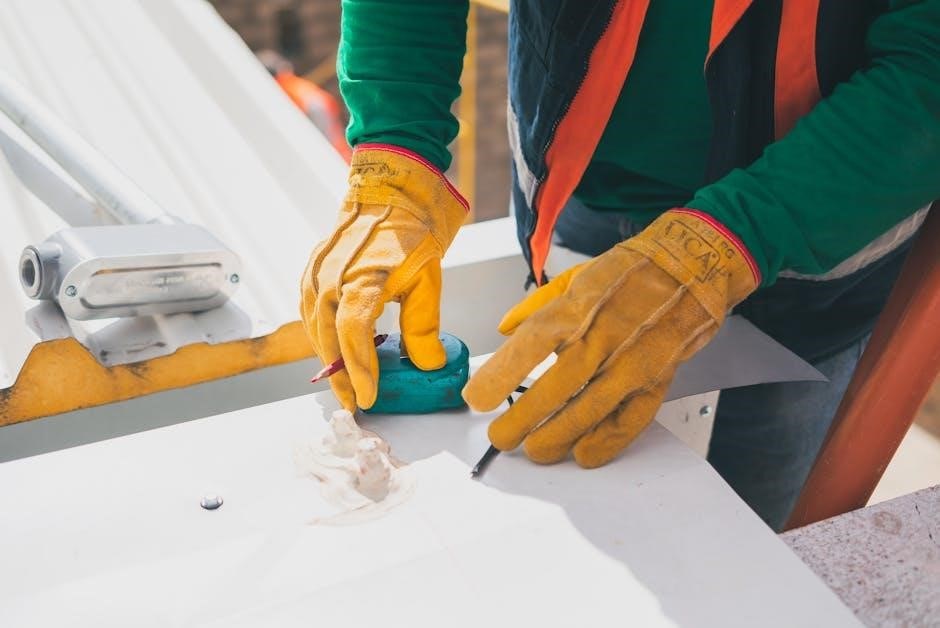
Wiring and Connections
Proper wiring is crucial for the Honeywell TH6210U2001 thermostat’s functionality. Always refer to the manual for terminal labels and ensure correct connections. Turn off power before starting work.
4.1 Understanding Wiring Configurations
Understanding wiring configurations is essential for a successful installation of the Honeywell TH6210U2001 thermostat. The thermostat supports various HVAC systems, including heating, cooling, and heat pump configurations. Familiarize yourself with the terminal labels (e.g., R, W, Y, G, C, etc.) and their functions. Ensure the wiring matches your system type, as incorrect connections can lead to malfunctions. Refer to the manual for compatibility charts and diagrams. For example, in a standard heating and cooling system, the R (24V power) and C (common) wires are mandatory. Additional wires like W (heat stage) and Y (cooling stage) may be required depending on your setup. Always follow the manufacturer’s guidelines and use the provided wiring diagram for accuracy. Proper wiring ensures reliable performance and safety.
4.2 Connecting Wires to the Thermostat
Connecting wires to the Honeywell TH6210U2001 thermostat requires careful attention to detail to ensure proper functionality. Begin by turning off the power to your HVAC system at the circuit breaker or fuse box. Locate the terminal connections on the thermostat base, labeled according to their functions (e.g., R, C, W, Y, G, etc.). Match each wire from your HVAC system to the corresponding terminal on the thermostat, ensuring secure connections. For example, the R wire connects to the 24V power supply, while the C wire provides a common connection. If your system includes additional features like humidity control or zoning, connect those wires accordingly. Use the provided wiring labels to keep track of connections. Once all wires are securely attached, double-check the connections against the wiring diagram in the manual before restoring power to the system.
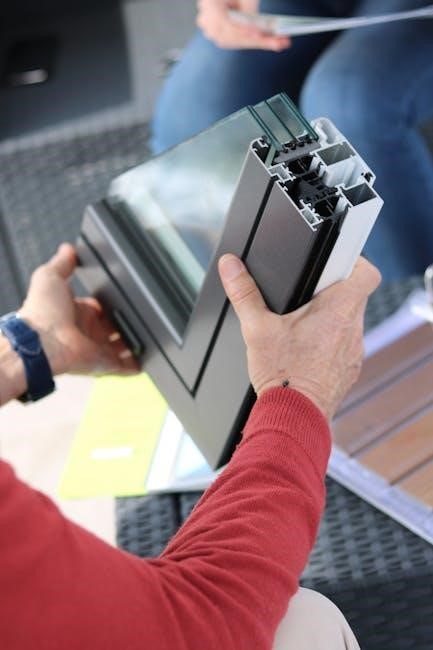
Advanced Features and Customization
The Honeywell TH6210U2001 offers advanced features like programmable scheduling, smart home integration, and remote access. Customize temperature settings, energy-saving modes, and system alerts to optimize comfort and efficiency.
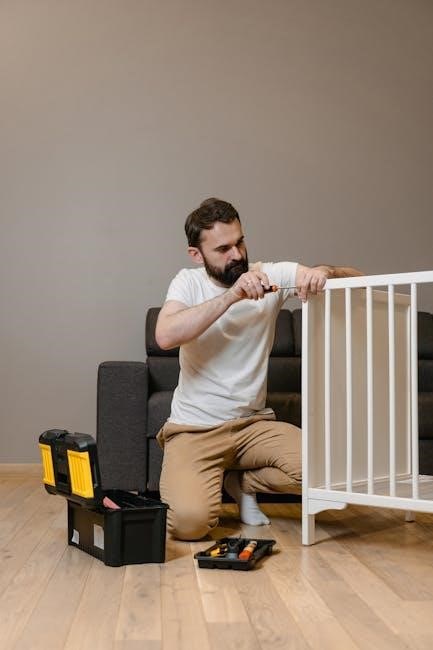
5.1 Programmable Scheduling
The Honeywell TH6210U2001 allows users to create customized temperature schedules, optimizing comfort and energy efficiency. Program different settings for weekdays, weekends, and vacations. The thermostat features a 7-day programmable schedule, enabling precise control over heating and cooling. Users can set up to four temperature periods per day, ensuring the system runs only when needed. The intuitive interface makes it easy to adjust schedules, while the large touchscreen display provides clear visibility. This feature helps reduce energy consumption by automating temperature adjustments. Additionally, the thermostat is Energy Star certified, ensuring energy-saving performance. Programmable scheduling can also be combined with smart home integration for enhanced convenience. By tailoring temperature settings to daily routines, homeowners can save on utility bills while maintaining consistent comfort levels throughout the day.
5.2 Smart Home Integration
The Honeywell TH6210U2001 thermostat seamlessly integrates with popular smart home systems, enhancing convenience and control. Compatible with Amazon Alexa and Google Assistant, users can adjust temperatures, set schedules, and monitor energy usage via voice commands or smartphone apps. This integration allows for a unified smart home experience, enabling effortless management of heating and cooling systems. The thermostat also supports remote sensors, which can be placed in different rooms to ensure balanced temperature distribution. Additionally, the Honeywell Home app provides real-time energy usage tracking, helping homeowners optimize their energy consumption. For enhanced security, the system regularly receives firmware updates to maintain performance and protect against vulnerabilities. Users can access detailed guides for smart home integration through Honeywell’s official support website, ensuring a smooth setup process.
5.3 Remote Access and Control
The Honeywell TH6210U2001 thermostat offers remote access and control through the Honeywell Home app, available for both iOS and Android devices. This feature allows users to adjust temperature settings, monitor system performance, and receive notifications from anywhere with an internet connection. Remote access is particularly useful for adjusting settings before arriving home or ensuring energy efficiency while away. The app enables users to create and modify schedules, override current settings, and monitor energy usage in real time. Additionally, the thermostat can integrate with geofencing technology, automatically adjusting temperatures based on the user’s location. Remote diagnostics also provide insights into system performance, helping identify potential issues before they escalate. For optimal functionality, ensure a stable internet connection and refer to the installation manual or Honeywell support for troubleshooting remote access setup.

Troubleshooting Common Issues
Troubleshooting common issues with the Honeywell TH6210U2001 involves identifying symptoms, checking power sources, and verifying wiring connections. Refer to the manual or Honeywell support for detailed solutions and guidance.
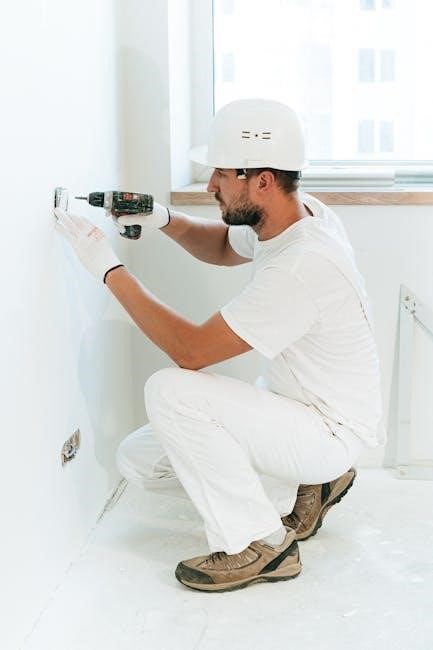
6.1 Identifying Common Problems
Common issues with the Honeywell TH6210U2001 may include display malfunctions, unresponsive controls, or inaccurate temperature readings. Other problems could involve connectivity failures, erroneous HVAC operation, or system lockouts. Users may also encounter issues like incorrect scheduling, sensor inaccuracies, or firmware glitches. Identifying these problems often starts with observing system behavior and comparing it to expected performance. Checking for error codes or alerts on the thermostat can provide clues. Additionally, verifying proper installation and connections is crucial, as many issues stem from wiring or setup errors. If the thermostat fails to power on, it may indicate a power supply problem or a faulty transformer. Strange noises, excessive cycling, or lack of heating/cooling are other signs of potential issues. Refer to the troubleshooting section for detailed guidance on diagnosing and resolving these common problems effectively.
6.2 Understanding Diagnostic Codes
The Honeywell TH6210U2001 thermostat uses diagnostic codes to help identify and resolve issues quickly. These codes are designed to provide clear indicators of system malfunctions or errors. Common diagnostic codes include E1, E2, and E3, each corresponding to specific problems such as temperature sensor issues, communication errors, or system faults. For example, an E1 code may indicate a discrepancy between the setpoint and actual temperature, while an E2 code could signal a communication failure between the thermostat and the HVAC system. Understanding these codes allows users to pinpoint the root cause of a problem, whether it’s related to wiring, sensors, or software. The manual provides a detailed list of codes and their meanings, enabling users to take appropriate corrective actions. By referencing these codes, homeowners or technicians can troubleshoot efficiently and restore system functionality without unnecessary delays.
6.3 Solutions for Common Issues
Addressing common issues with the Honeywell TH6210U2001 thermostat often involves simple troubleshooting steps. If the thermostat fails to power on, check the circuit breaker or fuse box to ensure power is supplied. For temperature inaccuracies, recalibrate the thermostat using the built-in calibration feature in the settings menu. If the thermostat does not respond to scheduling, perform a factory reset by pressing and holding the menu button for 10 seconds, then reconfigure the settings. Additionally, ensure the thermostat is properly mounted on a flat surface and free from obstructions. If the screen is unresponsive, clean it gently with a soft cloth to remove any debris. For persistent issues, consult the diagnostic codes (refer to Section 6.2) to identify the specific problem and apply the recommended solutions. Regular updates to the thermostat’s firmware can also resolve software-related issues. Always refer to the manual for detailed guidance.

Maintenance and Upkeep
Regularly clean the thermostat with a soft cloth to prevent dust buildup. Check for firmware updates to ensure optimal performance. Verify that the device is properly mounted and secured.
7.1 Cleaning the Thermostat
Cleaning the Honeywell TH6210U2001 thermostat is essential for maintaining its performance and efficiency. Use a soft, dry cloth to gently wipe the display and exterior surfaces. Avoid using harsh chemicals or liquids, as they may damage the device. For tougher dust or dirt buildup, lightly dampen the cloth with water, but ensure no moisture seeps into the thermostat. Power off the device before cleaning to prevent any electrical issues. Regular cleaning prevents dust from interfering with temperature sensors and ensures accurate readings. Additionally, inspect and clean the vents or grilles on the thermostat to promote proper airflow. Cleaning should be done every 1-2 months, depending on usage and environmental conditions. This simple maintenance step helps extend the lifespan of your thermostat and ensures reliable operation.
7.2 Updating Firmware
Updating the firmware of your Honeywell TH6210U2001 thermostat is crucial for ensuring optimal performance and accessing new features. To update, first, visit Honeywell’s official website and download the latest firmware version compatible with your device. Use a USB drive to transfer the update file to the thermostat. Power off the device before inserting the USB drive. Follow the on-screen instructions to initiate the update process, which may take several minutes. Do not disconnect power or remove the USB drive during the update, as this could cause system corruption. After completion, restart the thermostat to apply the changes. Regularly check for firmware updates to maintain system functionality and security. If issues arise, refer to the troubleshooting guide or contact Honeywell support for assistance. Always ensure the update is from an official source to avoid potential risks. Firmware updates are essential for a smooth and efficient user experience.
Final checks ensure proper installation and functionality. Verify all connections and settings. For additional support, visit Honeywell’s official website or consult certified professionals. Resources include user manuals, FAQs, and troubleshooting guides.
8.1 Final Checks and Verification
After completing the installation, perform a thorough verification to ensure the Honeywell TH6210U2001 thermostat functions correctly. Start by checking all wiring connections for accuracy and security. Power cycle the HVAC system to test heating, cooling, and fan operations. Verify that the thermostat display lights up and responds to button presses. Ensure programmable schedules are set correctly and that smart home integrations (if applicable) are functioning. Test remote access through the Honeywell Home app to confirm connectivity. Review the installation manual to ensure no steps were missed. If any issues arise, restart the system or reset the thermostat. For unresolved problems, refer to the troubleshooting section or contact Honeywell support. Proper verification ensures optimal performance and prevents future malfunctions.
8.2 Where to Find Additional Help
If you encounter challenges during or after installation, Honeywell provides multiple resources for assistance. Visit the official Honeywell website for downloadable manuals, FAQs, and troubleshooting guides specific to the TH6210U2001 model. The Honeywell Home app also offers in-app support and tutorials. For direct assistance, contact Honeywell’s customer support team via phone, email, or live chat. Additionally, authorized Honeywell dealers and HVAC professionals can provide expert help. Online forums and communities, such as Honeywell’s official forums, often have user discussions and solutions. Ensure to use only genuine Honeywell resources to maintain product warranty and safety compliance. These resources are designed to help you resolve issues efficiently and ensure optimal performance of your thermostat.
